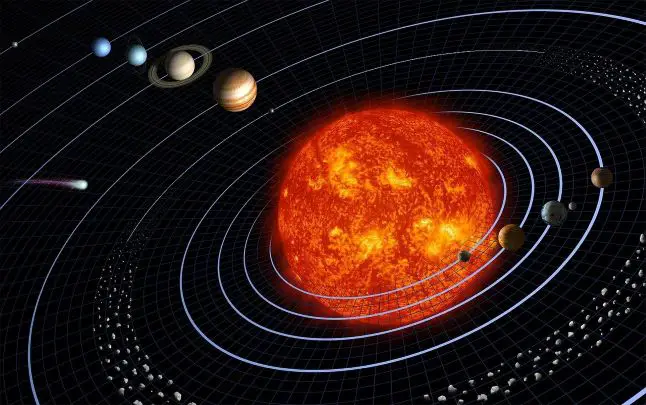The mesmerizing beauty of the universe never ceases to render us speechless. Billions and billions of galaxies. The sky is illuminated by infinite stars, each having its light. Then there is the Sun, orbited by 8 planets, 5 dwarf planets, thousands of asteroids, and about three trillion comets and icy bodies.
Yet, oceans of information about the ever-expanding universe remain latent with this much being known. These hidden treasures of information about the universe give rise to a string of never-ending questions. One such question that warrants an answer is about our neighboring planet. Why is Mars red?
Aggressive space missions fueled by satellites and rovers have unraveled the reason behind the dusky reddish glow of this planet. So let’s get ready for a space ride to discover the secrets of Mars with the help of this article.
All We Need To Know About Mars
Mars is the fourth planet from the Sun. The second smallest planet is named after the Roman god of war. It is about 141.6 million miles (228 million km) away from the Sun. With that being said, it takes about 12 minutes and 41 seconds for sunlight to reach Mars.
At aphelion, when it’s at the most significant distance from the Sun, it orbits at a distance of approximately 249,200,000 million km. Whereas at perihelion, when it’s closest to the Sun, it orbits at a distance of approximately 206,700,000 million km. Conclusively, Mars has an orbital period of 686.971 days at the distances mentioned above.
The planet has a mass of 6.4185 x 1023 kg with a volume of 1.6318 x 10^11 km^3. At its equator, Mars has a radius of approximately 3,396 km. In contrast, the radius at its polar region is approximately 3376 km. The surface gravity of Mars is 3.71 m/s^2.
It’s an icy, dusty, and arid planet. The average temperature ranges about -80 degrees Fahrenheit and can drop as low as -200 degrees Fahrenheit. Mars has a thin mantle and a solid core containing many lighter elements. The atmosphere of the planet is thin and is 95% carbon dioxide.
It can’t retain heat due to the absence of a thermal blanket. This is explained by its density of 5.514 g/cm^3. A small magnetic field cements the presence of a solid core.
As shown by the satellites and rovers, the planet’s surface is quite old and is filled with craters. Mars is known as the planet of energy, action, and desire in astrology.
The crown of having the largest mountain in the solar system is Mars. The Olympus Mons rises 78,000 feet, i.e., nearly 24 km above the surface.
Isn’t that fascinating?
Do Mars And Earth Have Any Similarities?
Well, astonishingly, the two neighboring planets have more than one thing in common. Both Earth and Mars are terrestrial planets. It simply means that both the planets are composed of rocks or metals. They have a hard surface with a molten heavy-metal core. Owing to their status as terrestrial planets, Earth and Mars have similar topological features such as volcanoes, craters, and valleys.
The list of similarities doesn’t wind up here itself. The most important similarity is the presence of water. However, water on Mars is present mainly in the form of ice. In addition, both the planets have seasonal cycles, clouds, and winds. Finally, the duration of the day is almost similar. A day on Earth is 24 hours, and it’s 24.6 hours on Mars.
What Is the distance Between Neighboring Planets?
The distance is variable as both the planets are orbiting the Sun, the distance between the two changes according to their positions. But we do know when Earth and Mars were the closest, they had been in 50,000 years.
August 2003 witnessed a historic moment when the two planets came the closest to one another. The Earth and Mars were 56 million km (34.8 million miles) apart. The sad part is we won’t be able to witness the repetition of this historical moment since NASA has predicted that the two planets won’t come that close until 2237.
So instead of sinking into sadness, let’s talk about the Martian moons to lift our mood.
Moons Of Mars
Asaph Hall, an American astronomer, discovered the two small moons, namely Phobos and Deimos, of the dry and dusty planet. There are some fascinating things to know about the moons of Mars. Phobos stands for fear. Deimos stands for panic. The story behind their names dates back to the times of Ares, God of wars.
The horses that pulled his chariot were Phobos and Deimos. Hence the names of the two Martian moons. Both the moons have an irregular shape. Phobos has a diameter of 14 miles (22 km) with a mass of 10.8×10^15 kg.
On the other hand, Deimos has a diameter of 7.5 miles (12 km) with a mass of 1.8×10^15 kg. Drawing a comparison between the diameter of the two moons shows that Phobos is twice as large as Deimos. However, they are counted amongst the smallest moons of the solar system.
Phobos orbits closer to Mars and has an orbital period of 7.66 hours. Its orbital speed is 2.14 km/s. At the same time, Deimos orbits farther and has an orbital period of 30.35 hours. Its orbital speed is 1.35 km/s. Compared to the orbiting distance between Earth and its moon, the Martian moons orbit much closer to Mars.
The surface of the Martian moons is composed of carbonaceous chondrite. The surface materials of both the moons appear similar to asteroids present in the outer asteroid belt. This pushes scientists worldwide to believe that Phobos and Deimos are nothing but captured asteroids.
While nothing about their origin is confirmed, it’s believed that over 2.7 billion years ago, a collision between a much larger Martian moon and a rock led to a massive explosion. This resulted in the formation of Phobos and Deimos.
Now let’s march ahead to the main question. Why is Mars red?
Why is Mars red?
As discussed earlier, the surface of Mars is extraordinarily arid, dusty, and is covered with soil that is rich in iron oxide, known as rust. The color of this rust is reddish brown which is the reason behind the reddish appearance of Mars. Owing to its reddish appearance, the planet is also known as the Red Planet.
And now we know the science behind it.
Is It Possible For Humans To Survive On Mars?
Space agencies are giving it their all to collect enough evidence that points toward the survival of human beings. Landers, rovers, and orbiters are on duty to explore the surface of Mars. We gather from the data collected so far that Mars is a small, dry and cold planet with no breathable air.
Whether or not life is possible on Mars remains a mystery.
Conclusion
Mars is the first planet that stakes a claim in the picture when it comes to life on a different planet. Although there is no sign of life on the planet, scientists are still trying to connect the dots, considering the past of Mars. But over the years, we’ve been successful in finding answers to many questions associated with Mars. For example, why is Mars red?
In this article, we’ve covered everything we need to know about Mars. But, unfortunately, all we can do is wait for evidence that holds water when it comes to the possibility of life on the red planet.
You May Like These Articles As Well:
 Being Human
Being Human





